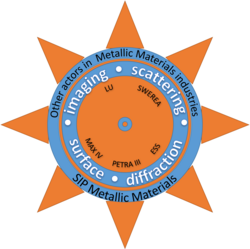Collaborations and Engagements
Studying Deformation and Fracture in Heterogeneous 3D-Architectured Material Microstructures
This project focuses on developing new strategically important collaboration in research and higher education between Lund University in Sweden and Kyoto University with Ritsumeikan University in Japan. The collaboration is in the area of developing advanced experimental and analytical methods for analysing deformation and fracture mechanisms in materials with heterogeneous 3D-architectured microstructures. Particular scientific focus is on the use of Japanese and Swedish large-scale facilities, i.e. Synchrotrons Spring-8, MAX IV and the Swedish beamline at Petra III, Neutron Sources J-PAC and the partnership network of ESS. The specific objectives within the education focus include
- capitalising on the just-established basis for collaboration;
- developing 'teaching-through-research' projects involving young researchers from all the partner institutions in both the countries;
- establishing regular international seminars and exchange visits by both young and senior researchers from Sweden and Japan. The completion of this project will open several new collaboration directions beyond the timeline of this program.
Big-Infrastructure Research for Big-Gains in Swedish Metallic Material Industry
The Swedish research and development landscape has been receiving an unprecedented upgrade with the emergence of two large-scale research infrastructures in Lund. These are frontier X-ray and Neutron sources synchrotron MAX IV Laboratory (MAX IV) and European Spallation Source ERIC (ESS). Along with the constructions of “Swedish High-Energy Materials Science” beamline at the PETRA III in Hamburg, Germany, they open exceptional opportunities for a leap in innovations and corresponding competitive advantages to all Swedish industries including those working with metallic materials.
This project aims at increasing the possibilities of industry, academia and research institutes to exploit efficiently these opportunities via the creation of a long-standing platform facilitating the linkages between researchers in industry, institutes and academia and experts in experimental techniques at MAX IV, the Swedish beamline at PETRA III and ESS. The platform is to be created alongside the planning and execution of a series of four workshops dedicated to experimental methods relevant to metallic materials and available at MAX IV, Petra III and ESS. As a result, we will communicate advantages of the large-scale facilities to the industrial players, boost cross-linkages between all experts within the metallic materials sector, and promote innovations in solving real-life challenges in Sweden. This project will allow pro-active concerted efforts of many actors in Swedish metallic material industries to drive the development of MAX IV, the Swedish beamline at PETRA III and ESS capacities towards the advantages of all parties involved.

